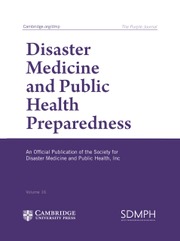No CrossRef data available.
Article contents
Evaluating the Effectiveness of Dry Decontamination Methods for Hazmat Incidents: A Scoping Review
Published online by Cambridge University Press: 23 June 2025
Abstract
CBRN incidents require specialized hazmat decontamination protocols to prevent secondary contamination and systemic toxicity. While wet decontamination is standard, it can present challenges in cold weather or when resources are limited. Dry decontamination offers an alternative and supportive approach, though its effectiveness across different contaminants remains unclear. This scoping review evaluates the effectiveness, advantages, and limitations of dry decontamination in hazmat incidents.
A scoping review was conducted using MEDLINE, CINAHL, and other databases. Following the PRISMA-ScR approach, 9 studies were selected from 234 identified articles. The review assessed decontamination techniques, materials, and effectiveness across different contaminants.
Dry decontamination is rapid, resource-efficient, and suitable for immediate use in pre-hospital and hospital settings, especially during mass casualty incidents (MCIs). Dry decontamination is highly effective for liquid contaminants, with blue roll and sterile trauma dressings removing over 80% of contaminants within minutes. However, dry decontamination is less effective for hair and particulate contaminants. Blotting and rubbing techniques significantly enhance decontamination efficiency.
Dry decontamination can be an effective alternative for wet decontamination, particularly for liquid contaminants, as a first-line approach for scenarios where wet decontamination is not a practical solution for logistical and environmental reasons. However, dry decontamination is less effective than wet decontamination for hair and particulate contaminants. Combining dry and wet decontamination is shown to be more effective. Identifying the need for including dry decontamination as an integral part of the CBRN response plan improves the efficacy of decontamination.
Keywords
Information
- Type
- Systematic Review
- Information
- Copyright
- © The Author(s), 2025. Published by Cambridge University Press on behalf of Society for Disaster Medicine and Public Health, Inc

